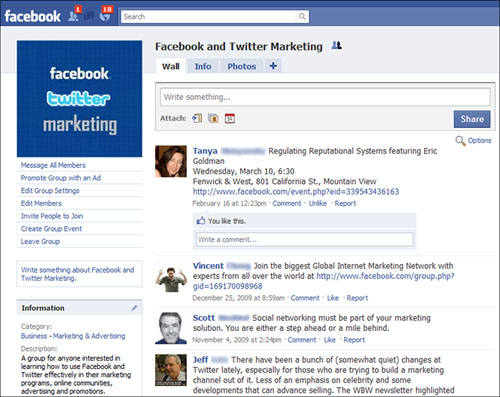7. Innovation and Collaboration in the Facebook Era
“Social networking is becoming social innovation. A new mode
of invention and production is in the making.”
—Don Tapscott, coauthor of Wikinomics
Innovation—the introduction of a new and useful method, process, product, or service—is the lifeblood of business and, indeed, of civilization. Innovation comes in many forms. This chapter focuses on product innovation, although you can apply the ideas presented here to other kinds of innovation.
Roughly speaking, the innovation process has four stages: generating concepts, prototyping, commercial implementation, and continual iteration (see Figure 7.1). Although these stages aren’t clear cut or sequential, they have guided most innovations in history.
Every stage is an intensely social process among inventors, collaborators, customers, business partners, critics, and others. It’s no wonder that product innovation is starting to move onto social networking sites. Companies previously had a one-sided relationship with customers. Product managers had very little information to work from, so product development mostly followed a “build it and hope they come” mentality, which is costly and high risk.
The social Web has changed the relationship between companies and customers from one-sided to a partnership. Social innovation takes the guesswork out of new product development because customers can tell companies exactly what is important. Armed with information about customers and what they want, companies can feel more empowered to go after new features and new markets. Because their ideas are heard, customers feel more accountable for providing input and more grateful when that input is incorporated into the design of new products. It’s a win–win for companies and their customers.
Figure 7.1
The cycle of innovation typically follows four stages, each containing multiple social processes: concept generation, prototyping, commercial implementation, and continual iteration.

Concept Generation
The first stage in innovation involves creatively brainstorming new ideas and then formulating those ideas into concepts. Traditionally, designated people within the company— usually product managers or research labs—created the ideas. The company generally drives the approach from the top down instead of from the bottom up (from the customer and employee base). Because of a lack of time or the right tools, customer input tends to be more serendipitous than systematic and typically ends up heavily biased toward feedback from the largest, most vocal customers.
The social Web reverses this traditional approach. By closely connecting product managers with internal and external communities in real time, the online social graph facilitates three important bottom-up processes in concept generation: inspiration, ideation, and expertise discovery.
Getting Inspired from Social Memes
Sometimes all it takes to come up with a killer concept is a little inspiration. Talking to customers is a good way to get inspired. It could be an article that someone forwarded to you, something you saw in a movie, or an interesting tidbit you overheard in the hallway that reminds you of something, makes you think about something new, or helps you see things in a new light.
At the heart of these ideas, thoughts, and tidbits that inspire us are memes, a term Richard Dawkins coined in his 1976 book, The Selfish Gene, to describe the unit of information representing a basic idea that can be transferred from one individual to another. Dawkins applied evolutionary principles about how viruses propagate and mutate to explain the spread of ideas and cultural phenomena.
How can product managers expose themselves to the right amount of the right memes to become inspired without feeling overwhelmed?
It’s important to have access to both external and internal meme streams. For external memes, people use tweets and Facebook status messages to share what they’re thinking about, what they’re doing, how they’re doing, and other memes. It is a blank slate: “Jill is …”— Jill can type whatever she wants, and it will be broadcast to her network. Twitter and Facebook feeds have generally done a good job of helping people “digest” the stream of memes that continually flows from friends. By investing in building diverse networks of contacts on social networking sites that cut across different homogeneous groups, product managers can increase the chances that they will be exposed to radically new thinking.
Product managers can also use Twitter search to see trending topics or get a pulse on what people are saying about something in particular. For example, I periodically search on “The Facebook Era” at http://search.twitter.com to find out what is being said about this book. It’s been a great source of ideas and inspiration (see Figure 7.2). Popular free applications such as Hootsuite, TweetDeck, and Seesmic let you save Twitter searches on the keywords, phrases, and hashtags that you want to track over time.
External memes are generally good at helping product managers identify problems. Internal memes are often good at helping them find solutions. Your colleagues are probably thinking about the same or similar problems (often from a slightly different angle) and how to solve them—and your colleagues share your goal of making the company successful. Memes spread every day in meetings, at the water cooler, and in emails that get forwarded to certain distribution lists. Unfortunately, with everything else going on in an organization, the capability for memes to be transmitted isn’t as great as it should be. Especially as organizations get bigger, it becomes increasingly difficult to share memes. One reason start-up companies are so effective at getting inspired and coming up with new concepts is that it’s easier to brainstorm and share thoughts with the whole team.
Figure 7.2
This figure shows my saved Twitter searches inside Hootsuite. Comments, articles, and musings from my Twitter followers, people that I follow, hashtags that I follow, and people who mention the book or my name. These searches have been an invaluable source of ideas, inspiration, and feedback in writing this book.
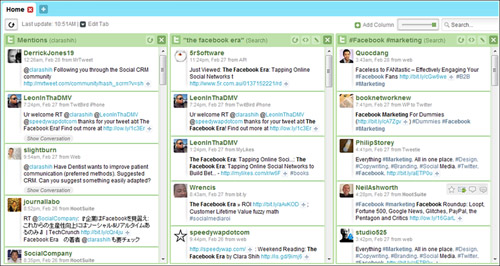
Not everyone has something breakthrough to say all the time, so rarely is having everyone hang out at the water cooler efficient or feasible. Nor does everyone care about what everyone else has to say, so emailing the entire company every time someone has an idea is too distracting and disruptive.
Yammer and Socialcast are meme-broadcast tools for individual company networks. Both are similar to Twitter for business. Yammer, in particular, aims to make organizations more productive through the exchange of short, frequently updated answers to one simple question:“What are you working on?” Any employee who has a working email address in the company’s domain can join and start posting on the company’s Yammer page. Colleagues can then discuss ideas, ask questions, post news, and share links.
Unlike an email blast, Yammer is noninvasive. It provides what Leisa Reichelt and others call ambient intimacy within organizations. Employees visit Yammer when they have a free moment and have something to say or want to see what other people are saying. Unlike on Facebook or Twitter, all the memes are related to work and are visible only to other employees. Some of the memes might be silly or not readily applicable. But at a minimum, they enable employees to feel better connected to their coworkers and might provide just the right meme for them to make progress on an idea (see Figure 7.3).
Figure 7.3
Yammer is a status-broadcasting tool that enables employees of the same company to answer and view colleagues’ answers to a simple question:“What are you working on?” This is Hearsay Labs’ Yammer page.
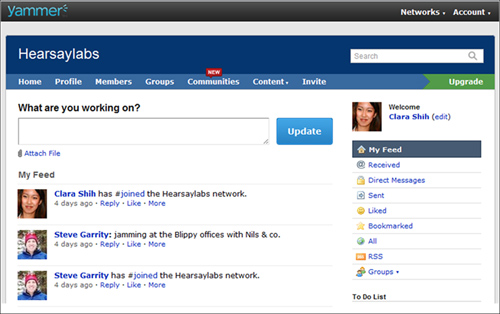
Status updates are getting incorporated everywhere. Following Yammer’s cue, a number of enterprise-sharing and collaboration applications have started to add status updates as a feature. Among these are Microsoft SharePoint, IBM Lotus Connections, ThoughtFarmer, and Salesforce Chatter.
Through status messages and serendipity, the social Web extends the water-cooler effect across geographic regions and time zones. It helps promote a sense of inclusiveness to everyone in your organization and helps working mothers, employees at satellite offices, and others who must work remotely to be at less of a disadvantage in contributing to innovation and engaging with the rest of the company.
Crowdsourcing Ideation
Inspiration is good, but ideas are even more valuable when they are more concrete and actionable. We introduced the notion of crowdsourcing in Chapter 5, “Customer Service in the Facebook Era,” in the context of customer support. Product managers can also use crowdsourcing techniques to generate ideas from the community for product development.
Depending on the product and competitive situation, it might make sense to engage with internal communities, external communities, or both. The advantage of internal communities is that your colleagues are often the people with the greatest expertise about your product or service because they live, work, and think about it every day.
Internal communities also provide a confidentiality advantage if you are concerned about competitors copying your ideas and even beating you to market. The advantages of external communities are that customers and partners can bring new, often more realistic perspectives about your product, and they will feel more engaged, grateful, and loyal that you value their input and are willing to be transparent. In many situations, it makes sense to engage with both kinds of communities, but to varying degrees and about different topics.
Few product managers have time to interact regularly with every customer on a one-to-one basis. Crowdsourcing enables one-to-many conversations between the product manager and the community through these steps:
1. Establish an ideation forum—The product manager or an online community manager sets up a forum for ideas to be solicited, generated, and collected.
2. Seed the conversation—To get things going, the product manager might need to post some initial ideas or ask open-ended questions that get community members to participate. Some product managers have even launched contests for user-generated product ideas to achieve greater commitment and a better response (see Figure 7.4).
Figure 7.4
Cisco has issued its second-annual I-Prize Contest to solicit ideas for the Cisco “next billion-dollar business.” Entrepreneurs from around the world can log in, submit ideas, vote, and collaborate with Cisco product managers and executives. I-Prize runs on the Spigit social ideation platform.
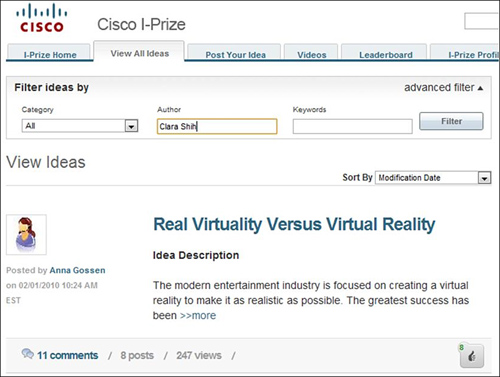
Courtesy of Cisco Systems, Inc.
3. Encourage customers to interact with one another—Product managers can motivate and encourage participation by setting up a strong system of trust, identity, and recognition. Lithium’s communities, in particular, have a lot of gamelike features that create incentives for participation. A lot of the best ideas will come out of this process of customers sharing their ideas and opinions with one another while the product manager is in the backseat listening and facilitating.
4. Act on results—When a good idea is suggested, the product manager might want to intervene and ask the community to develop it further. When it is sufficiently developed, it might be time to take the idea back to internal teams and start prototyping, periodically sharing updates with the community.
5. Reach out to key contributors—In most communities, a small number of members are the most active and vocal with their ideas and opinions—the classic 80/20 Rule. Product managers should engage in more in-depth conversations with these individuals to dig deeper and gain even more insights.
As powerful as social network communities are for encouraging customer brand conversations, they can also be a lot of work to manage when used for ideation. Unlike marketing, involving customers in the innovation process is not just about making them feel engaged. A concrete end goal exists to find the best ideas and act on them. Often the hardest part is making sense of the tremendous number of ideas that can be generated. It really is like finding a needle in a haystack.
Tools are being developed to help product managers aggregate, summarize, analyze, and prioritize community feedback. The most popular tools are UserVoice, Spigit (see Figure 7.4), Brightidea, and Salesforce Ideas. For example, UserVoice ideation communities provide an end-to-end system to capture comments, track bugs, and manage new feature requests. The capability to create widget instances of a UserVoice community helps further permeate these ideation opportunities across different Web properties, including blogs and Facebook Pages.
Ideation communities have evolved during the last couple years. First, to prevent or minimize duplicate ideas on most of these sites, a search is run against any new idea being submitted to make sure it doesn’t already exist (or overlap too substantially with an existing idea). Second, most sites have the capability to create structured categories for classifying different ideas.
Especially for larger, geographically dispersed organizations, social ideation tools provide a great solution for internal collaboration. Experian, a global financial information services company headquartered in Dublin, has found great results managing the employee ideation pipeline using Brightidea. With a large number of offices spread across the globe, including more than 20 locations in the United States alone, the company (and many other companies in similar situations) faced a difficult communication and coordination challenge. Experian transitioned its employee idea submission process from spreadsheets to Brightidea. A year after deploying Brightidea, Experian launched 100 new products, including a major product, ChoiceScore, that originated from an employee idea. In addition to the revenue impact, employee engagement has boosted morale, productivity, and retention.
Online communities have been around for some time and are starting to become essential tools for ideation. What makes social network ideation of the last few years different? One reason is the strong online identity component we talked about in Chapter 2, “The New Social Norms.” People feel more engaged in providing ideas because it helps them build their credibility and personal brand. Another reason is the rising popularity of community voting on idea sites, inspired by sites such as Digg.
In the following guest expert sidebar, IDEO designer Gentry Underwood helps us understand the new paradigm of crowdsourced innovation and design emerging on the social Web.
The Social Design Process
Gentry Underwood
The term open innovation is all the rage lately, in no small part because of the success of paradigm-shifting experiments in design and problem solving by companies such as Innocentive, Netflix, and 99designs. The idea is attractive because these platforms open the innovation process to a vast crowd of talent who can compete for the chance to produce a winning design. And although it’s still the early days for crowdsourced creativity, we already know quite a bit about what works, what doesn’t, and how social networking is changing the face of innovation:
• From who you know to who’s the best—Historically, analog social networking has limited innovation. Searching for creative help has meant pinging your network and hoping to find someone with the right skills and availability. This talent hunting is tedious and inefficient, and is similar to fishing in an oil drum.
Most open innovation networks reverse this problem by throwing out a challenge to the crowd and letting designers compete for the work by doing it up front, winner take all. But the contest model can get you only so far. The best designers often shy away from such models because the risk is too high that they won’t get paid. And many innovation problems aren’t well suited for a contest-type deliverable. In the long run, tapping much larger digital social networks will replace using analog ones. Searching for people based on what they’re good at, what they know, and who they’ve worked with has never been easier. And we’re only getting started.
• From vague and intangible to operational and well defined—Working with broader networks of talent often means working across distances and in numbers previously thought impossible. And although no substitute exists for a handful of creative people sitting in a room together and using every wall as a shared display, remote collaboration technologies get better every day.
When working with others remotely, the “brief”—that is, the definition of the problem that needs to be solved and any known constraints of a solution—has to be extremely clear, with lots of specific and well-defined milestones along the way. Therefore, the best innovators in a social networking age are the ones who are capable of expressing themselves clearly and breaking down problems into specific, executable chunks.
• From the designer-as-aristocrat to everyone-as-designer—One of the most exciting results of the changes we’re seeing in innovation is how they open the process of design to anyone who wants to partake. Ultimately, design is a way, a method of solving problems and creating what previously didn’t exist. Such creativity is a uniquely human trait, not one that’s unique to certain humans. Just as social media tears down traditional publication models for a long tail of anyone-as-publisher, modern technology is tearing down the traditional model of elite designer.
If you want to be a designer, it comes down to how good you are at solving certain kinds of problems creatively and who knows about your particular skill. Historically, that might have meant hoping and dreaming that you got famous enough for traditional media to immortalize you and spread your name around the world; now all you have to do is find the right networks and express yourself within them.
Social networking has turned many undervalued savants into respected niche geniuses with enough work to keep them full and happy. The long tail applies to people, too.
Gentry Underwood (@gentry) is director of knowledge sharing at IDEO.
Finding Answers and Expertise
Beyond inspiration and ideation, concept generation requires finding the right expertise within your company to finish baking half-baked concepts. Product managers often have a general sense for what areas they want to focus on or what problems to solve, but they don’t know where to begin or how to make progress on an abstract concept.
Traditionally, people have relied on tacit, anecdotal knowledge about who knows what and who used to work where to track down internal expertise. However, this is extremely difficult in organizations that are larger, that are geographically dispersed, or that have high employee turnover—the trend most companies are headed in. Also, the needed expertise often lies across organizational and functional boundaries where tacit knowledge and regular communication links are weakest.
On Facebook and especially LinkedIn, member profiles typically include past employers and roles, projects, and areas of interest and expertise. Using these social networking sites enables product managers to tap not only among their direct connections and coworkers, but also among friends of friends and extended networks.
How does it work? At the most basic level, you can perform a search for people on social networking sites. LinkedIn enables you to search based on name, title, location, and keywords. Facebook lets you search based on location, workplace, and school.
In addition to finding people, you can find answers. LinkedIn Answers is a free service that enables members of LinkedIn to ask and answer professional questions of their networks. For example, people in my network have posted these recent questions:
• “Attention Flash Developers: What books do you recommend for learning ActionScript? I’m currently using Flash 8.”
• “Are you aware of company policies that address quota relief for sales reps on maternity leave?”
• “Are there any CPC ad marketplaces or aggregators (not tags or feeds)?”
Community members are motivated to provide answers because it builds up their expertise reputation on LinkedIn, which comes in handy if they are looking for a new job or project (see Figure 7.5). If they know you personally, answering your question also builds their social capital with you. You can ask certain questions privately to select members of your network if the question involves sensitive or confidential information, and you can publicly ask other questions when the more “social” aspect encourages reputation-building responses from the community-at-large.
Figure 7.5
LinkedIn Answers enables LinkedIn community members to post professional questions to their networks. People who answer questions can build their reputation by earning points for expertise in the question’s category.
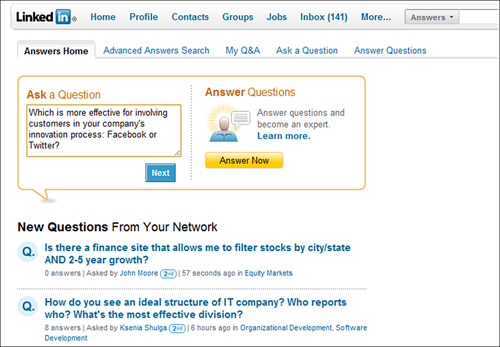
In addition to encouraging employees to use public social networking sites to track down external expertise, companies are beginning to invest in internal knowledge and expertise management tools, such as Connectbeam and IBM Lotus Connections.
Connectbeam builds expertise profiles on every employee based on projects they have worked on, articles they have bookmarked, and information they have posted to enterprise wikis, blogs, and other systems. Product managers can use Connectbeam to search for subject matter experts in the company. In addition, Connectbeam proactively recommends colleagues with whom to network based on similar expertise, projects, and interests (see Figure 7.6).
Online social networking is helping product managers be more efficient and effective at locating the internal and external resources needed to make progress on their ideas. In particular, expertise-discovery solutions such as Connectbeam help minimize redundant efforts within companies and enable product managers to leverage past related work done in a particular area of interest.
Figure 7.6
Connectbeam is a popular enterprise social networking solution that specializes in expertise discovery.
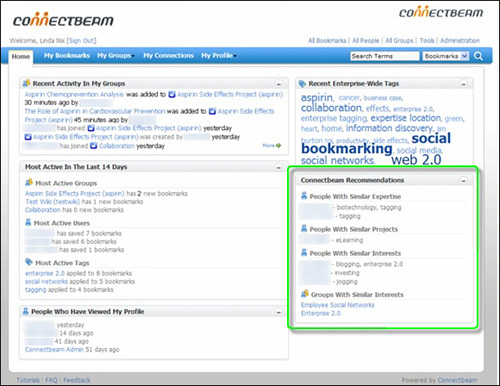
Prototyping
Prototyping—that is, the rapid development, testing, and iteration of products before a commercial version is created and released to the mass market—is a critical step in the innovation process. In many ways, prototyping largely consists of concept generation and iteration, which are covered in separate sections in this chapter. Prototyping also requires collaboration and feedback channels.
Collaboration
Successful collaboration is built on trust and mutual commitment. As we discussed in Chapter 3, “How Relationships and Social Capital Are Changing,” social networking sites enable individuals to build better rapport and, therefore, can contribute to a more trusting and satisfying team environment. In particular, three aspects of online social networking make it ideally suited for supporting collaborative prototyping efforts: casual communication and interaction modes for establishing rapport; the capability to connect with individuals outside your networks, including different organizations and geographies; and the capability to find functional experts and view the expertise of collaboration team members.
In addition to the informal collaboration that takes place on public social networking sites such as Facebook and LinkedIn, a number of software companies have emerged in the last few years that provide enterprise collaborative productivity tools and intranets. Pioneers in this space include Lotus Connections (as mentioned earlier), Trampoline Systems (more focused on sales collaboration), ThoughtFarmer, Small World Labs, and Socialtext (see Figure 7.7). Most of these offer some combination of the following features to help employees work better together: enterprise wikis, blogs, social networks, employee directories, calendars, tag browsing, feeds, document collaboration, employee learning and training, and messaging.
Reprinted by permission
Figure 7.7
Socialtext provides a suite of “enterprise 2.0” internal collaboration tools, including private, Twitterlike microblogging (shown here), social networking, blogs, wikis, and dashboards.
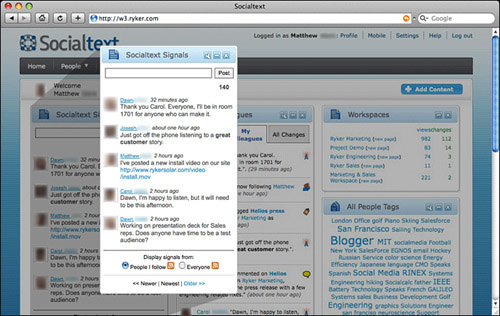
In the following guest expert sidebar, innovation expert Deb Schultz gives us valuable advice on how to facilitate collaborative innovation in the community.
Successful Collaboration on the Social Web
Deborah Schultz
“If you’re not failing every now and again, it’s a sign you’re not doing anything very innovative.”
—The “great philosopher” Woody Allen
Innovative ideas often appear when we least expect them. I am often asked, how do you create an environment where innovation can flourish? To catalyze collaboration and innovation, certain elements need to be in place whether you are working within a social network or in an internal enterprise peer group. Most important, the environment must believe that failure is indeed learning. Consider these five tips on how to start collaborating on the social Web:
1. Build a foundation of trust—Without trust, no one wants to collaborate or share ideas—whether online or offline. A community of co-collaboration with customers is very different than an internal employee community because the motivations for participation are very different. Understanding the motivations of members and communicating program benefits, roles, and purpose sets a tone of trust from the outset to drive collaboration.
2. Start small, be choiceful—Collaboration is an art and a skill. If you are new to connecting with customers or employees, start small to build up your “social muscles.” Put up a forum and ask for feedback on an existing feature, or proactively email a small group of loyal customers and ask them whether they might be interested in collaborating in the future.
3. Iteration trumps perfection—Don’t try to craft a perfect program behind closed doors that you will unleash to the world. Realize that collaboration and innovation are, by nature, iterative and a bit messy and involve give-and-take. You might design a program to do A and then gather feedback from customers who really think that B is much more important. Be open to change and be listening for the gems that pop up when you least expect them.
4. Understand the culture and norms of the community you are joining—If you are connecting to an existing community, spend some time there, be part of the community, and add value. Get to understand the raison d’être of the community before you pounce in as a business or individual. If you join or create a Facebook Page, get to know the people there and the cultural norms that emerge. Only then can you add value to the group.
5. Focus on people and relationships—You are now in an ongoing relationship with a community. When collaborating online, the most important resource you can put in place is the right people to engage with your community. If you build it, they will not come. Every successful online community has a human being in there connecting people and ideas and catalyzing action. I call this person the tummler—the role is part host, part connector, part rabble-rouser, and part moderator. Tummlers are more than merely community managers (you cannot manage community); they are the social fabric of the space—the people who build trust, forge connections, and weave among the nodes in the network to bring out the best in others.
Deborah Schultz (@debs) is a cofounder and partner, leading innovation and design at Altimeter Group.
Feedback Channels
The act of prototyping also demands continual feedback from internal and external parties. Sometimes it might make sense to solicit feedback from the “masses” through crowdsourced ideation communities, as described in the previous section. But that typically requires significant lead time and is overkill for prototyping. Obtaining frequent, high-quality feedback from an important few stakeholders is often more helpful.
Backboard (recently acquired by Box.net) is a useful social feedback tool that helps people do just this. Backboard enables prototypers to invite feedback and approval on documents, images, and presentations from their LinkedIn, Gmail, and Yahoo! contacts. Reviewers can mark up files to provide feedback using a combination of drawing and text comments (see Figure 7.8). They can also view one another’s suggestions and approve different versions of files.
Figure 7.8
Backboard is an innovative social feedback tool for documents, images, and presentations. Product managers and others use Backboard for obtaining frequent, high-quality feedback on concept prototypes. You can try it at http://getbackboard.com.
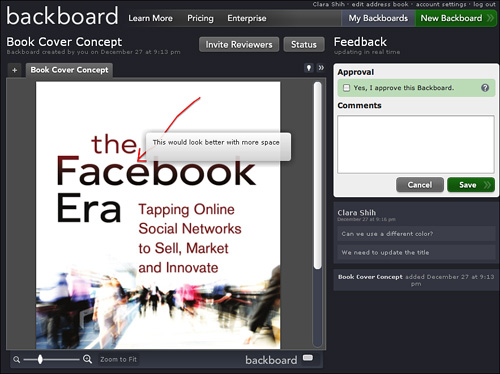
Commercial Implementation
An important distinction between innovation and invention is that innovation is the successful practical deployment of an idea or invention. That is, innovation is about execution as much as anything else. Having a good idea and prototype is necessary, but not enough.
Execution is a very social process. Successful execution requires both internal buy-in from colleagues and executives, and external buy-in from customers, partners, and others. Online social networking can help.
Winning Internal Buy-In
Before focusing on your product’s go-to-market plan, you have to win over the right stakeholders and decision makers internally. Support from colleagues and executives is essential for mobilizing the necessary resources to build the product, secure sufficient levels of marketing investment for the product, and persuade sales reps to talk about the product with customers.
Many of the concepts from Chapter 3 about building social capital are applicable for winning internal buy-in. By cultivating strong and diverse entrepreneurial networks across different departments in your company, you will be better positioned to ask for help, feedback, and support. The flattening effect of online social networks discussed previously means that wherever you are in the organizational hierarchy, executives and decision makers might be more accessible to you than in offline networking situations.
Using communication tools such as Twitter, Yammer, or Socialcast, as described in the earlier section, you can broadcast updates about your project and do some internal marketing about your initiative. People can’t support something if they don’t know about it or don’t understand it. This stage of the innovation cycle when you have a solid prototype is an ideal time to engage people broadly across the organization and solicit additional feedback and support.
Finally, nothing provides more compelling evidence to make the case for a new product than demonstrated customer demand. The crowdsourcing techniques discussed earlier, such as ideation communities on Facebook, can provide reliable customer data to back up your internal pitch. Have customers been receptive to the product concept? Was it their idea to begin with? Has the idea received a lot of votes, comments, and attention? Product managers should collect this feedback, both in aggregate and as a few anecdotal examples, and socialize it within the organization.
In the following guest expert sidebar, Ezra Callahan and Leah Pearlman share how Facebook itself uses Facebook to build a collaborative culture of sharing, brainstorming, and employee bonding.
How Facebook Uses Facebook to Drive Collaboration
Ezra Callahan and Leah Pearlman
Here at Facebook (the company), we use Facebook (the product) in much the same way as our users—perhaps a bit more actively, on average, but not fundamentally different in nature. We upload photos from our vacations. We write notes about our lives. We share the big news of our day.
We congratulate each other on engagements and babies. We support each other through marathons and fundraisers. We friend one another’s spouses and roommates. The ubiquity with which we share our lives with one another has several profound impacts on our work environment and the success of the business.
As we connect on a personal level, deeper professional relationships inevitably develop. These personal connections lead to increased patience, cooperation, and empathy—qualities that we believe lead to effective collaboration.
This openness also has a special effect on the relationship between employees and employer: It breeds mutual respect and trust. Employees engage in honest conversations, open feedback, and more collaborative decision making.
Open and efficient communication leads to a lot of idea sharing from diverse perspectives. Facebook (the product) is designed to help popular content—the good ideas—gather support and generate calls to action. Real change results from this process, which is evident in the many ways that Facebook has already had an impact on the world. Facebook (the company) is a microcosm of this very chain of events. Using privacy settings, employees can casually brainstorm new ideas with each other through the site itself. Good ideas gather support, which broadens the distribution among others in the company. Without any formal process, the great ideas reach the relevant development teams with a lot of creative and diverse thought already invested.
Facebook does not fit the mold of what one would usually think of as an “enterprise tool.” Yet it proves to be an incredibly powerful means of building energy and loyalty within a company, surfacing great ideas, and promoting an openness that drives collaboration, efficiency, and success.
Ezra Callahan and Leah Pearlman work on internal communications at Facebook.
Winning Over the Market
In previous chapters, we discussed social sales and marketing techniques for winning over customers. This is especially critical for innovative products and services that might not yet have customer trust, proven success, and widespread demand.
The diffusion of innovation theory offers a good way for thinking about how online social networking affects the commercial success of a new product. In his 1962 book The Diffusion of Innovations, Everett Rogers describes how innovation spreads through members of a society following an S-curve—initially with a few early adopters, followed by the majority, until the innovation becomes mainstream. By facilitating communication across vast networks, social networking sites accelerate the rate of diffusion for a product, as shown in Figure 7.9.
Figure 7.9
Social networking sites accelerate the traditional S-curve of innovation diffusion, enabling more people to adopt new products more quickly.
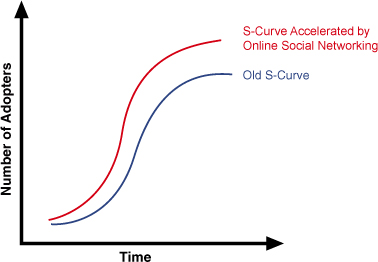
Diffusion research looks at the factors that might accelerate, increase, or decrease the chances that members of a culture will adopt a new idea or product. According to Rogers, innovation diffusion from an individual’s perspective occurs through five stages: knowledge, persuasion, decision, implementation, and confirmation. Online social networking changes each of these stages:
1. Knowledge or exposure—To accept an innovation, people first need to know about it. The passive word-of-mouth broadcasts that occur on social networking sites, such as Facebook News Feeds, encourage the diffusion of information through a trusted medium that people have opted into (see Figure 7.10).
Figure 7.10
Product managers can follow Twitter accounts and join Facebook Groups, such as this one that I moderate, to discover content and contacts relating to the product and in peripheral knowledge areas. Twitter followers and Facebook Group members receive updates in their stream.
2. Persuasion—Next, individuals must be persuaded about the value and validity of the innovation. Social proof and transitive trust play an important role: Because Person X endorses the innovation and Person Y trusts Person X, Person Y is more likely to become persuaded in favor of the innovation. Customers are more likely to be persuaded of an innovation (or to at least try a new product) if they were involved in its development. Internal corporate stakeholders are more likely to be persuaded to pursue development of a new product if the customer community has voted it up. It’s hard to argue with customer data.
3. Decision—Individuals then need to make a decision to adopt or reject an innovation. Social networking sites help in a few ways. First, they can help advertisers create a sense of urgency and force a decision with time-sensitive campaigns (introduced in the previous chapter). Displaying a timely offer that is associated with a real-world event with an expiration date might accelerate an individual’s decision of whether to accept an innovation. Second, for people who aren’t ready to decide, social networking sites can help prolong the decision to give the innovation more chances to be accepted. For example, feed stories—including information and products—linger instead of disappearing right away and are searchable, as shown in Figure 7.11. Finally, ideation tools provide opportunities for customers to provide feedback on what’s missing or not quite right so that the company has a second chance to make the innovation better until customers decide to accept the new product.
Figure 7.11
Public voting and commenting, such as on Dell’s IdeaStorm community, provides valuable social proof and transitive trust to encourage participation and support.
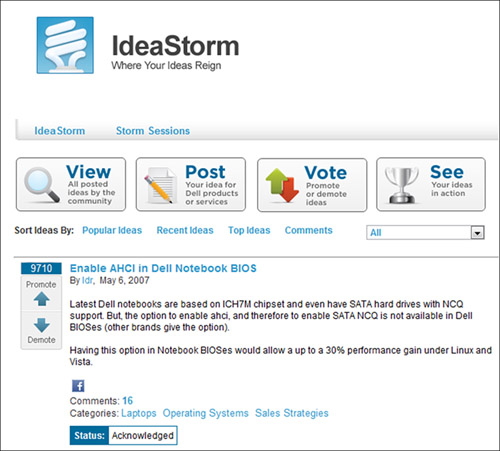
© 2010 Dell Inc. All rights reserved.
4. Implementation— At this point, individuals must carry through with setting up and actually using the innovation. As we talked about in Chapter 5, social network communities help connect novice adopters with others (both employees and expert customer users) who might be more experienced with the product and be able to offer help and guidance. The encouragement and support from people you know both accelerates implementation and increases the likelihood of success.
5. Confirmation—Finally, individuals evaluate the results of an innovation they have chosen to adopt. Here again, it might be useful and more enjoyable to reflect on your experience in the context of a social network community instead of in isolation. Which of your friends also adopted this innovation? What are their thoughts and reactions, and how do they compare with yours? Customer evangelists can publicly sing your product’s praises via Twitter or by “liking” your product’s Facebook Page.
Continual Iteration
After you’ve implemented your idea and released the product to market, your ongoing success depends on your capability to continually respond to customer feedback and iterate. This is especially crucial if you have launched a radical new product, you have a radical new take on an existing product, or you are addressing a new market.
Feedback
Similar to the concept-generation stage, it can be highly efficient to crowdsource feedback from social network communities. After all, feedback is just another form of ideation focused specifically on how to improve existing products. As a product manager, feedback might automatically come to you through these forums you have set up. Otherwise, it’s a good idea to solicit qualitative feedback by moderating these forums, asking open-ended questions, and even offering real or virtual rewards for participation. if needed.
Companies can also establish systematic feedback channels by using Facebook survey applications or posting links to online surveys on their Facebook Page. Feedback from Twitter and this book’s Facebook Page was instrumental in the writing of the second edition.
Case Study: Driving Development of The Facebook Era, Second Edition from Feedback on Facebook
When I sat down in January to begin work on this edition of the book, I looked to readers on Facebook and Twitter, in addition to Amazon reviews, for feedback and inspiration. I collected ideas using these methods:
• Polls—Polls are a good way to get quick data and decide among a few clearly defined alternatives. When we were trying to decide on the subtitle for this edition, I posted a poll to make it easier for people to weigh in (and then tweeted it to get even more people involved). The next section talks more about polls.
• Ad test—To collect more objective evidence beyond the poll, we ran a small ad campaign on the different subtitle options and compared the click-through rate. In our case, the click data confirmed the poll data. This edition’s subtitle is the result of the polls and ads.
• Status updates—Compared to polls, tweets and Facebook status updates are more free form. As shown in Figure 7.12, I asked a general question to readers, “Any suggestions, special requests, or new direction you want me to take?” and received a variety of responses, many of which I have incorporated into the book. For example, the ideas to include new chapters on small business and customer service, more industry-specific examples, and a discussion of Facebook versus Google all came from open feedback on Facebook and Twitter.
• Private messages—During the last year and a half, I’ve received a number of Facebook messages and Twitter direct messages. I’ve read them all. Many of you asked for nonprofit and political campaign coverage, which inspired the new chapter in this book.
Figure 7.12
I relied heavily on Facebook Page status messages to quickly post questions and get answers on what I should change and add to this edition of the book. A big thank-you to everyone who weighed in.
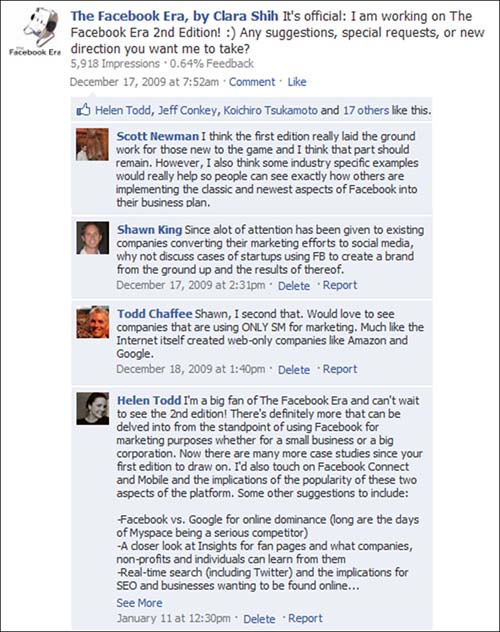
Polls
Polls are an easy way to conduct simple market research or get customer feedback on specific product decisions. When products are already available, product managers often find themselves faced with decisions of whether to offer slight variations on the product, such as offering it in different colors, adding or subtracting functionality to create premium and basic versions, and providing a children’s version. These kinds of “either/or” and multiple-choice questions are perfect for polls. Almost every online social network enables community managers to incorporate polls (see Figure 7.13).
Figure 7.13
Polls such as this one posted to the book’s Facebook Page can be a good way of periodically engaging the community about questions and trends that everyone might find interesting.

Transforming Customers into Partners
Online social networking tools can help product managers transform customers into true participant–partners. In the Facebook Era, companies and customers are able to achieve a new level of conversation that is bidirectional and extends across product development, sales, marketing, and customer support. Thanks to the social graph, not only are customers encouraged to engage with your company, but they are also motivated to engage with their friends and colleagues about your company—contributing to your sales, marketing, support, and product innovation efforts.
![]() Each of the four stages of innovation (concept generation, prototyping, commercial implementation, and continual iteration) is a highly social process involving multiple actors.
Each of the four stages of innovation (concept generation, prototyping, commercial implementation, and continual iteration) is a highly social process involving multiple actors.
![]() A combination of internal (such as those shared on sites like Yammer) and external memes (such as those shared on sites like Twitter) is important to fully stimulate the creative process.
A combination of internal (such as those shared on sites like Yammer) and external memes (such as those shared on sites like Twitter) is important to fully stimulate the creative process.
![]() Increasingly, companies are crowdsourcing the ideation process to communities of customers and communities of employees.
Increasingly, companies are crowdsourcing the ideation process to communities of customers and communities of employees.
![]() Internal collaboration and networking tools such as Connectbeam,
Internal collaboration and networking tools such as Connectbeam,
![]() Lotus Connections, and Salesforce Chatter enable employees to locate internal expertise.
Lotus Connections, and Salesforce Chatter enable employees to locate internal expertise.
![]() Collaboration tools are not only good for ideation, but they are also very valuable in generating awareness and support for new products, especially if they originated from community ideas.
Collaboration tools are not only good for ideation, but they are also very valuable in generating awareness and support for new products, especially if they originated from community ideas.
> > > TIPS and TODO’s
![]() Build a culture of trust and collaboration by establishing clear ground rules and goals, and then recognizing and rewarding participants.
Build a culture of trust and collaboration by establishing clear ground rules and goals, and then recognizing and rewarding participants.
![]() Encourage product managers and R&D staff to sign up for Yammer and Twitter to monitor and be inspired by conversations, sentiments, and ideas in their field of work.
Encourage product managers and R&D staff to sign up for Yammer and Twitter to monitor and be inspired by conversations, sentiments, and ideas in their field of work.
![]() Consider building a crowdsourced ideation community to track market demand for proposed features and generate new ideas.
Consider building a crowdsourced ideation community to track market demand for proposed features and generate new ideas.
![]() Use contests and prizes as incentives for community members to contribute high-quality ideas.
Use contests and prizes as incentives for community members to contribute high-quality ideas.
![]() Train remote innovation teams on better communication skills so they can express themselves clearly and break down problems into specific pieces for different individuals to solve.
Train remote innovation teams on better communication skills so they can express themselves clearly and break down problems into specific pieces for different individuals to solve.

